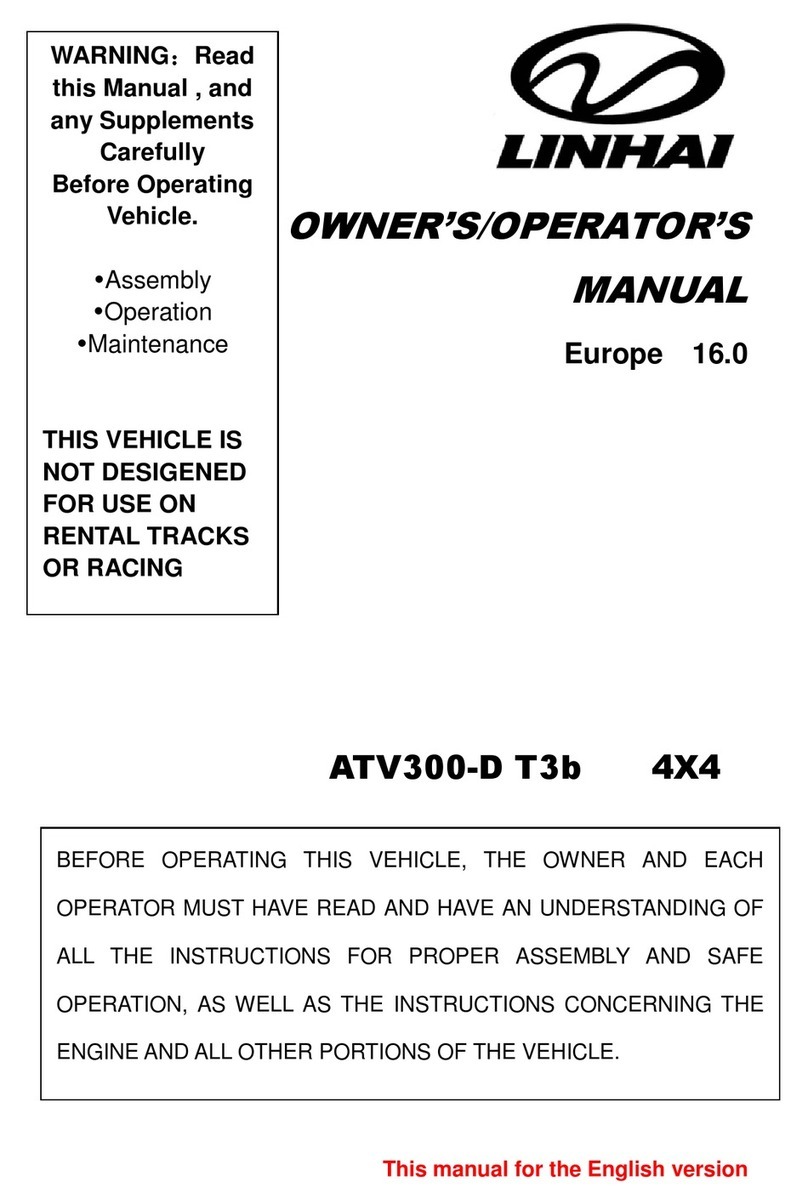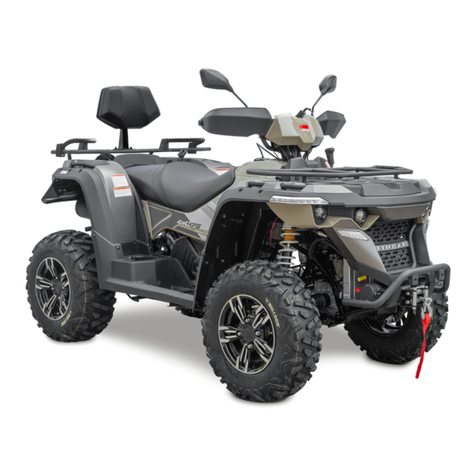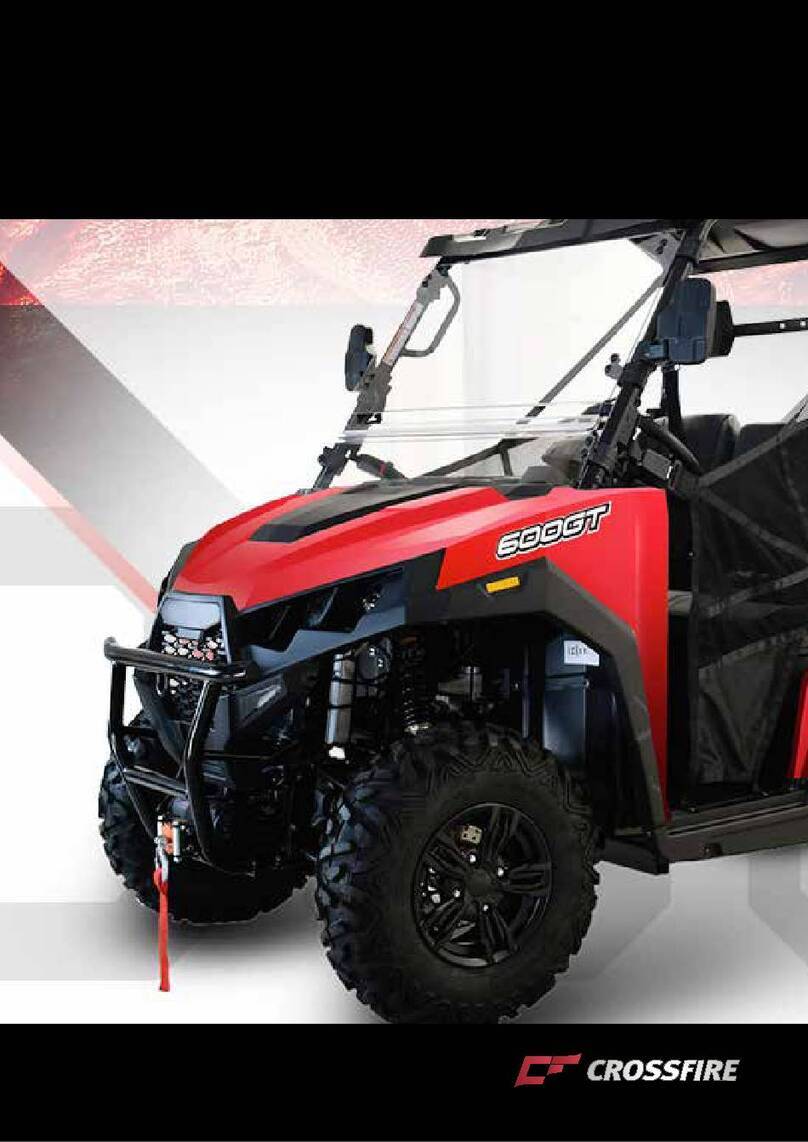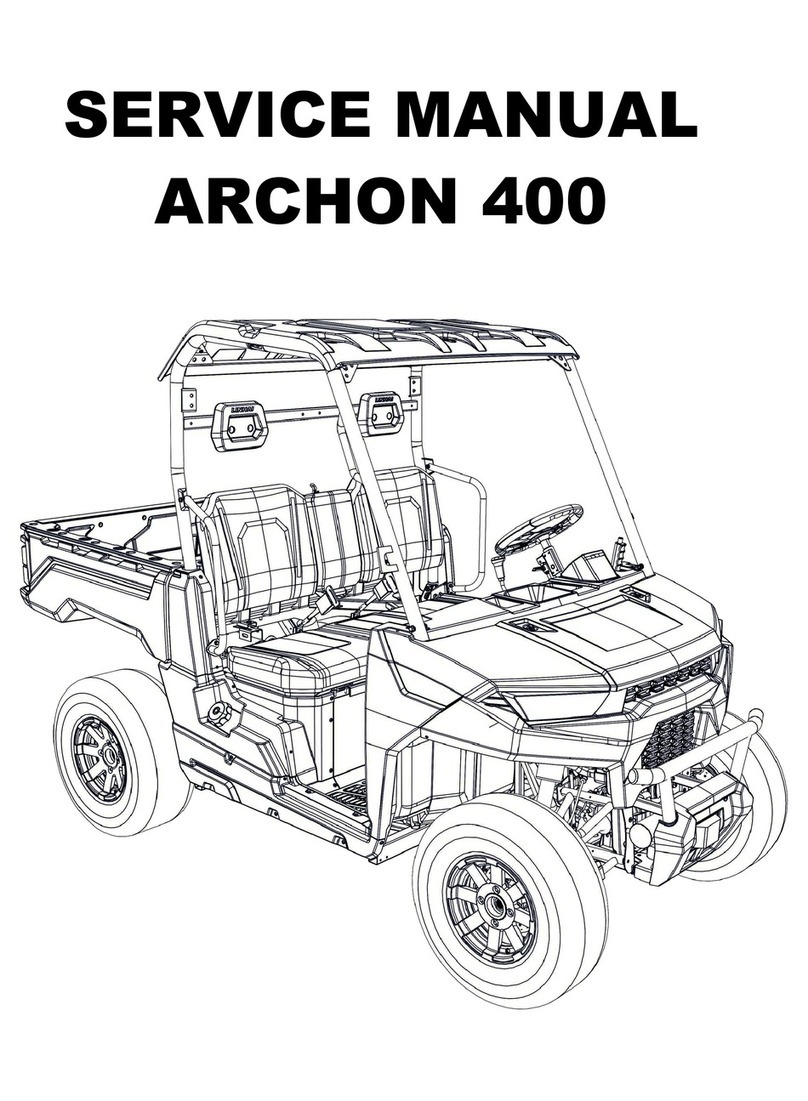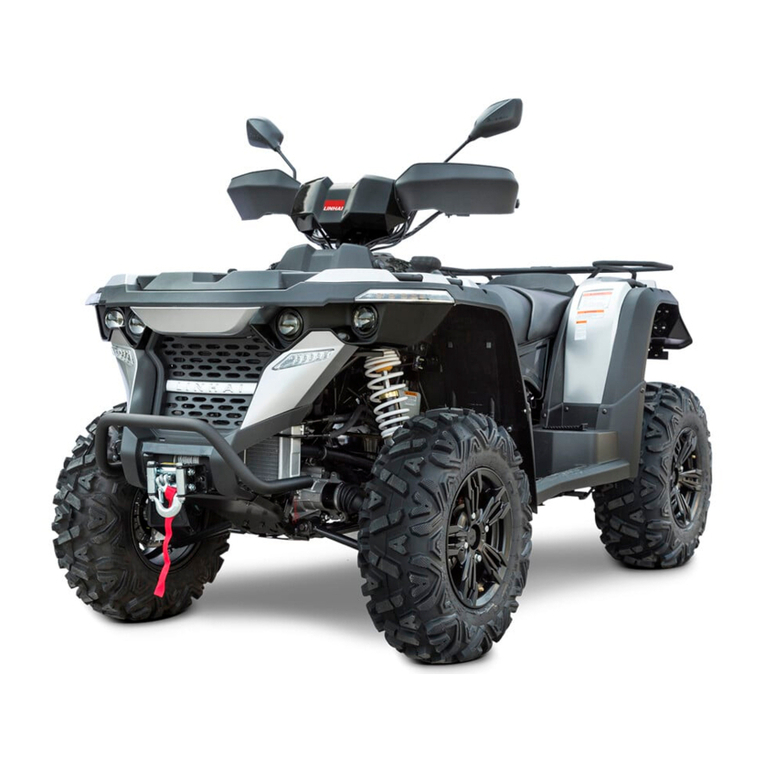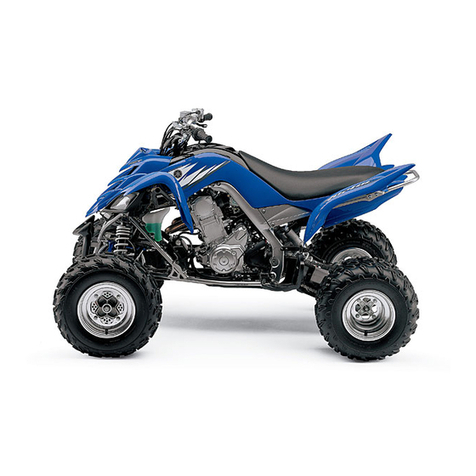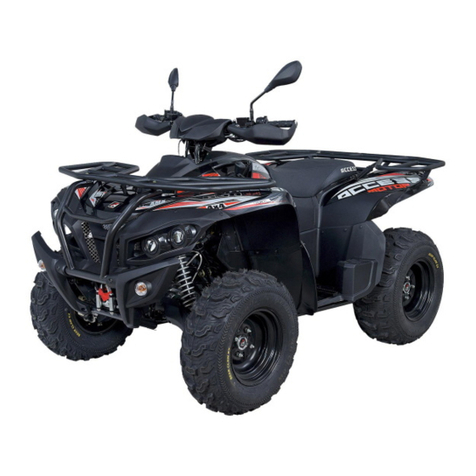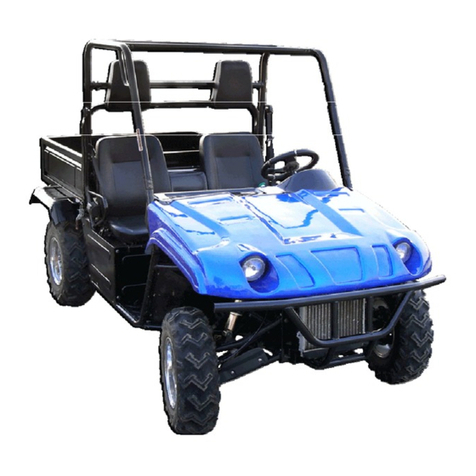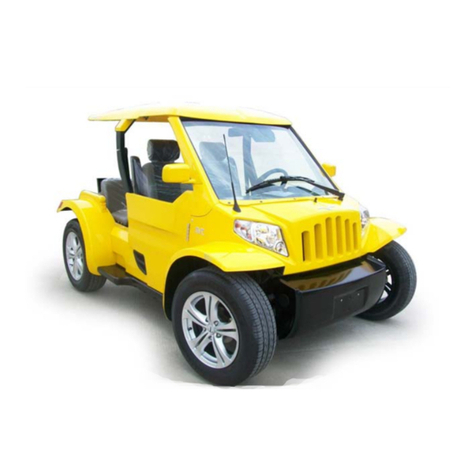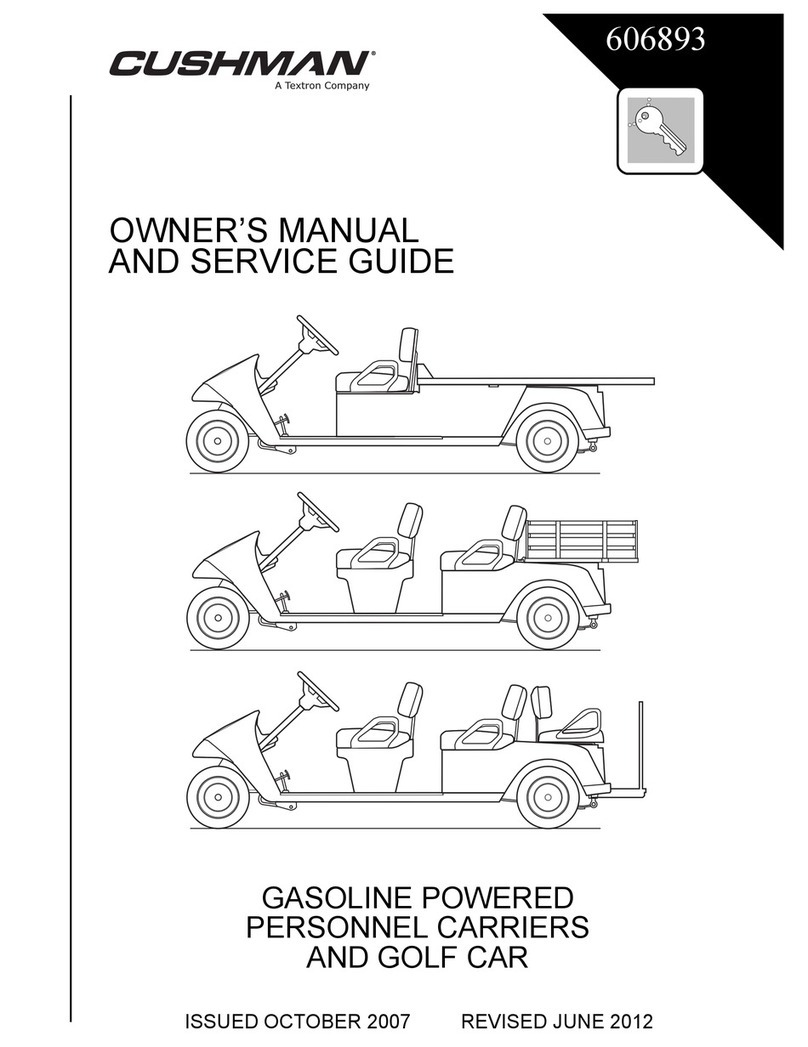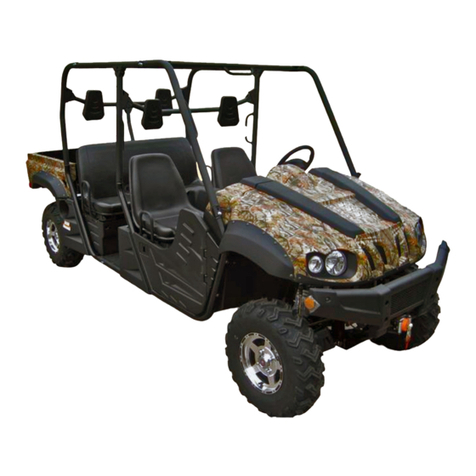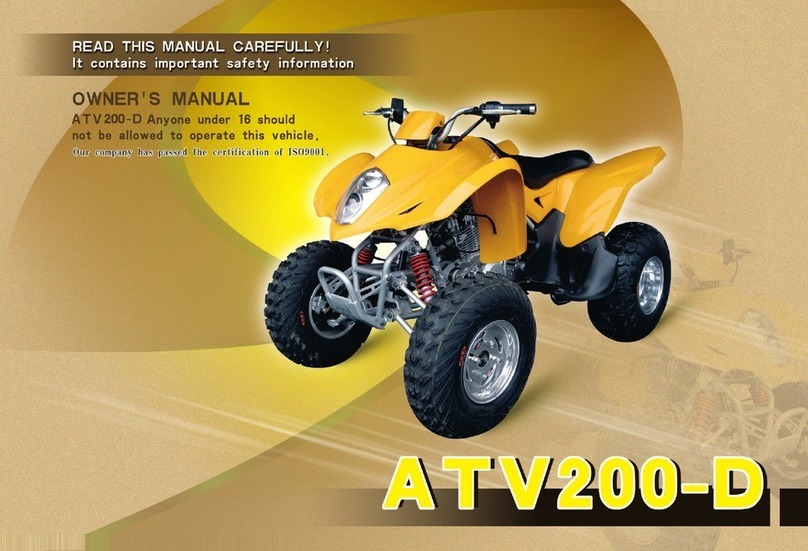Linhai LH400CUV-2 User manual

LH400CUV-2
SERVICE MANUAL

NOTICE
This manual was produced by the Linhai Group primarily for use by Linhai dealers
and their qualified mechanics. It is not possible to include all the knowledge of a
mechanic in one manual, so it is assumed that anyone who uses this book to perform
maintenance and repairs on Linhai vehicle has a basic understanding of the
mechanical ideas and the procedures of vehicle repair. Repairs attempted by anyone
without this knowledge are likely to render the vehicle unsafe and unfit for use.
Linhai Group is continually striving to improve all its models. Modifications and sig-
nificant changes in specifications or procedures will be forwarded to all authorized
Linhai dealers and will appear in future editions of this manual where applicable.
NOTE:
Designs and specifications are subject to change without notice.
IMPORTANT INFORMATION
Particularly important information is distinguished in this manual by the following
notations.
The Safety Alert Symbol means ATTENTION! BECOME ALERT!
YOUR SAFETY IS INVOLVED!

Failure to follow WARNING instructions could result in severe
injury or death to the vehicle operator, passenger, a bystander, or
a person checking or repairing the vehicle.
CAUTION: A CAUTION indicates special precautions that must be taken to
avoid damage to the vehicle.
NOTE: A NOTE provides key information to make procedures easier or
clearer.
CONTENTS
CHAPTER1 ……………………………………………………….General Information
CHAPTER2 ………………………………………….……………………Maintenance
CHAPTER3…………………………………….……….….…………………….Engine
CHAPTER4…………………………………………..…………………………Chassis
CHAPTER5………………………………………………….……………….Final Drive
CHAPTER6……………………………………………….………………Transmission
CHAPTER7………………………………………………………………………Brakes
CHAPTER8………………………………………………….….……………..Electrical

Never run an engine in an enclosed area. Carbon monoxide exhaust gas is
poisonous and can cause severe injury or death. Always start engines outdoors.
Gasoline is extremely flammable and explosive under certain conditions. Battery
electrolyte is poisonous. It contains sulfuric acid. Serious burns can result from
contact with skin, eyes or clothing. Always keep alert and wear protection.
Exhaust system components are very hot during and after use of UTV. Never service
when the engine is warm or hot. Escaping steam from cooling system or hot oil from
the machine can cause severe burns. The engine must be cool before service.
Crate of the UTV and parts in the UTV maybe have sharp edge, always pay attention
and wear protection.

CHAPTER 1 GENERALINFORMATION CUV SERVICE MANUAL 09.0
CHAPTER 1 GENERAL PAGE. 1-
1
CHAPTER 1 GENERAL INFORMATION
The parts of different types/ variants/ versions maybe un-interchangeable, even some parts have
almost same appearance. Always refer to Parts Manual of each CUV model for spare parts
information and service.
1.1 IMPORTANT INFORMATION
1.2 V.I.N AND ENGINE SERIAL NUMBER
1.3 VEHICLE DIMENSIONS

CHAPTER 1 GENERALINFORMATION CUV SERVICE MANUAL 09.0
CHAPTER 1 GENERAL PAGE. 1-
2
1.1 IMPORTANT INFORMATION
PREPARATION FOR REMOVAL PROCEDURES
1. Remove all dirt, mud, dust and foreign material before removal and disassembly.
2. Use proper tools and cleaning equipment.
3. When disassembling the machine, always keep mated parts together. This includes gears,
cylinders, pistons and other parts that have been ”mated ”through normal wear. Mated part must
always be reused or replaced as an assembly.
4. During machine disassembly, clean all parts and place them in trays in the order of disassembly.
This will speed up assembly and allow for the correct installation of all parts.
5. Keep all parts away from any source of fire.
REPLACEMENT PARTS
Use only genuine parts for all replacements. Use recommended oil and grease for all lubrication
jobs. Other brands may be similar in function and appearance, but inferior in quality.
GASKETS,OIL SEALS AND O-RINGS
1. Replace all gaskets seals and O-rings when overhauling the engine. All gasket surfaces, oil seal
lips and O-rings must be cleaned.
2. Properly oil all mating parts and bearings during reassembly. Apply grease to the oil seal lips.
LOCK WASHERS/PLATES AND COTTER PINS
Replace all lock washers/plates and cotter pins
after removal. Bend lock tabs along the bolt or
nut flats after the bolt or nut has been tightened
to specification.
BEARINGS AND OIL SEALS
Install bearings and oil seals so that the
manufacturer’s marks or numbers are visible.
When installing oil seals, apply a light coating of
lightweight lithium base grease to the seal lips.
Oil bearings liberally when installing, if
appropriate.
①oil seal
CAUTION:
Do not use compressed air to spin the bearings
dry. This will damage the bearing surfaces.
①Bearing
CIRCLIPS
1. Check all circlips carefully before reassembly.
Always replace piston pin clips after one use.

CHAPTER 1 GENERALINFORMATION CUV SERVICE MANUAL 09.0
CHAPTER 1 GENERAL PAGE. 1-
3
Replace distorted circlips. When installing a
circlip①, make sure that the sharp-edged
corner ②is positioned opposite the thrust
③it receives. See sectional view.
④Shaft
CHECKING OF CONNECTIONS
Dealing with stains, rust, moisture, etc. on the
connector.
1. Disconnect:
Connector
2. Dry each terminal with an air blower.
3. Connect and disconnect the connector two or
three.
4. Pull the lead to check that it will not come off.
5. If the terminal comes off, bend up the pin ①
and reinset the terminal into the connector.
6. Connect:
Connector
NOTE:
The two connectors ”click ”together.
7. Check for continuity with a tester.
NOTE:
If there is no continuity, clean the terminals.
Be sure to perform the steps 1 to 7 listed
above when checking the wire harness.
Use the tester on the connector as shown.
Never run an engine in an enclosed area. Carbon monoxide exhaust gas is poisonous and can
cause severe injury or death. Always start engines outdoors.
Gasoline is extremely flammable and explosive under certain conditions. Battery electrolyte is
poisonous. It contains sulfuric acid. Serious burns can result from contact with skin, eyes or clothing.
Always keep alert and wear protection..
Exhaust system components are very hot during and after use of CUV. Never service when the
engine is warm or hot. Escaping steam from cooling system or hot oil from the machine can cause
severe burns. The engine must be cool before service.
Crate of the CUV and parts in the CUV maybe have sharp edge, always pay attention and wear
protection.

CHAPTER 1 GENERALINFORMATION CUV SERVICE MANUAL 09.0
CHAPTER 1 GENERAL PAGE. 1-
4
CONVERSION TABLE
How to use the CONVERSION TABLE
Use this table to convert METRIC unit data to IMPERIAL unit data.
Ex.
METRIC MULIPLIER IMP
**mm x 0. 3937 = **in
**cm x 0.03937 = **in
CONVERSION TABLE
METRIC TO IMP
Known
Multiplier
Result
Torque
m·kg
m·kg
cm·kg
cm·kg
7.233
86.794
0.0723
0.8679
ft·lb
In·lb
ft·lb
In·lb
Weight
kg
g
2.205
0.03527
lb
oz
Distance
km/h
km
m
m
cm
mm
0.6214
0.6214
3.281
1.094
0.3927
0.03927
mph
mi
ft
yd
in
in
Volume/
Capacity
cc(cm3)
cc(cm3)
lit(liter)
lit(liter)
0.03527
0.06102
0.8799
0.2199
oz(IMP liq.)
cu·in
qt (IMP liq.)
gal(IMP liq.)
Miscellaneous
kg/mm
kg/cm2
Centigrade
55.997
14.2234
9/5(℃)+32
lb/in
psi(lb/in2 )
Fahrenheit(°F)

CHAPTER 1 GENERALINFORMATION CUV SERVICE MANUAL 09.0
CHAPTER 1 GENERAL PAGE. 1-
5
1.2 V.I.N AND ENGINE SERIAL NUMBER
The vehicle identification number ○
1is stamped
into the front of the frame tube.
The engine serial number ○
1is stamped into left
side of engine crankcase.

CHAPTER 1 GENERALINFORMATION CUV SERVICE MANUAL 09.0
CHAPTER 1 GENERAL PAGE. 1-
6
1.3 VEHICLE DIMENSIONS
Note.
The on-road equipments (rear view mirror, turn lights, etc.) are not Standard Equipment for USA.

CHAPTER 1 GENERALINFORMATION CUV SERVICE MANUAL 09.0
CHAPTER 1 GENERAL PAGE. 1-
7
NOTES
12

CHAPTER 2 MAINTENANCE CUV SERVICE MANUA 09.0
CHAPTER 2 MAINTENANCE PAGE. 2-
1
CHAPTER 2 MAINTENANCE
The parts of different types/ variants/ versions maybe un-interchangeable, even some parts
have almost same appearance. Always refer to Parts Manual of each CUV model for spare
parts information and service.
2.1 PERIODIC MAINTENANCE
2.2 THROTTLE PEDAL INSPECTION
2.3 CHOKE ADJUSTMETN
2.4 FUEL SYSTEM
2.5 TOE ALIGNMENT
2.6 BRAKING SYSTEM INSPECTION
2.7 SUSPENSION SPRING RPELOAD ADJUSTMENT
2.8 WHEELS
2.9 TIRE PRESSURE
3.0 FRAME, NUTS, BOLTS, FASTENERS

CHAPTER 2 MAINTENANCE CUV SERVICE MANUA 09.0
CHAPTER 2 MAINTENANCE PAGE. 2-
2
2.1 PERIODIC MAINTENANCE
GENARAL
CAUTION
Mark on the following chart
DL :Due to the nature of the adjustments marked with a DL on the following chart, it is
recommended that service be performed by an authorized dealer.
▲:Service/Inspect more frequently when operating in adverse conditions.
PERIODIC MAINTENANCE SCHEDULE
Careful periodic maintenance will help keep your vehicle in the safest, most reliable condition.
Inspection, adjustment and lubrication intervals of important components are explained in the
following chart on the following pages.
Maintenance intervals are based upon average riding conditions and an average vehicle
speed of approximately 16km/h (10 miles per hour). Vehicles subjected to severe use, such
as operation in wet or dusty areas, should be inspected and serviced more frequently.
Inspect, clean, lubricate, adjust or replace parts as necessary.
NOTE: Inspection may reveal the need for replacement parts. Always use genuine parts
available from your dealer.
Service and adjustments are critical. If you are not familiar with safe service and adjustment
procedures, have a qualified dealer perform these operations.
A = Adjust I = Inspect
C = Clean L = Lubricate
D = Drain R = Replace
T =Tighten to Correct Torque
Item
Hours
When
Remarks
Service (Main) Brake System
/
Pre-ride
I
Parking Brake
/
Pre-ride
I
Tires
/
Pre-ride
I
Wheels
/
Pre-ride
I
Frame nuts, bolts fasteners
/
Pre-ride
I
▲
Air Filter-Pre-Cleaner
/
Daily
I C
Coolant/Level
/
Daily
I
Coolant
150
Annually
R
Coolant strength
25 hrs
3 months
I Inspect strength seasonally
▲
Air Box Sediment Tube
/
Daily
D

CHAPTER 2 MAINTENANCE CUV SERVICE MANUA 09.0
CHAPTER 2 MAINTENANCE PAGE. 2-
3
Headlamp Inspection
/
Daily
C
apply dielectric grease to connector
when replaced
Tail lamp inspection
/
Daily
C
apply dielectric grease to socket when
replaced
▲
Air Filter-Main Element
2
Weekly
IC
Replace if necessary
▲
Transmission Oil Level
10
Monthly
I
change annually
Battery Terminals
10
Monthly
I C
Battery fluid level
10
Monthly
I
DL
Brake pad wear
10
Monthly
I
▲
Gear case Oil
10
Monthly
C
150
annually
R
Engine Cylinder Head and
Cylinder Base Fasteners
25
3 months
I
(re-torque required at first service only)
▲
General Lubrication
all fittings, pivots, cables, etc.
25
3 months
L
Engine Oil-Level
/
Daily
I
Engine Oil Change
30 hrs
3 months
R
Break-in Service at 1 month. Change oil
more often in cold weather use.
▲
Oil Filter
50 hrs
6 months
IC
▲
Engine breather hose
100 hrs
6 months
I
Carburetor Float Bowl
50 hrs
6 months
Drain bowl periodically and prior to
storage
Throttle Cable
/
Pre-ride
I
DL
Throttle Cable/Throttle pedal
50 hrs
6 months
A L (Grease M) R if necessary

CHAPTER 2 MAINTENANCE CUV SERVICE MANUA 09.0
CHAPTER 2 MAINTENANCE PAGE. 2-
4
Shift linkage
50 hrs
6 months
IA R if necessary
DL
Transmission belt
50 hrs
6 months
I
R if necessary
▲
Steering
50 hrs
6 months
I L T if necessary
▲
Front Suspension
50 hrs
6 months
IL
T if necessary
▲
Rear Suspension
50 hrs
6 months
I
T if necessary
Spark Plug
100 hrs
12 months
I
R if necessary
DL
Ignition Timing
100 hrs
12 months
I
Adjust as needed
DL
Fuel System
100 hrs
12 months
Check for leaks at tank, cap, lines, fuel
valve, filter, and carburetor. Replace
lines every 2 years.
DL
Fuel Filter
100 hrs
12 months
R
Radiator
100 hrs
12 months
I R
Cooling System hoses
50 hrs
6 months
I
R if necessary
Spark arrestor
10 hrs
monthly
C
R if necessary
DL
Clutches (drive and Driven)
25 hrs
3 months
I R
R if necessary
Engine mounts
25 hrs
3 months
IT
DL
Valve clearance
100 hrs
12 months
IA
DL
Shift selector box
(H/L/R/N)
200 hrs
24 months
Change grease every two years
Exhaust system
100hrs
12 months
I
DL
Brake fluid Level
/
Pre-ride
I

CHAPTER 2 MAINTENANCE CUV SERVICE MANUA 09.0
CHAPTER 2 MAINTENANCE PAGE. 2-
5
Brake fluid
200 hrs
24 months
Change every two years
Idle Speed
/
As Required
A
DL
Toe adjustment
/
As Required
Periodic inspection, adjust when parts
are replaced
Headlight Aim
/
As Required
Adjust if necessary
▲
DL
Ball joint (A arm- strut)
10 hrs
monthly
I, (for damage, wear, and play)
R. Replace if necessary
LUBRICANT AND FLUID
Item
Lube Rec
Method
Frequency
1.Engine Oil
SAE 15W/40 SE
Add to proper
level on dipstick
Check level daily
2. Brake Fluid
DOT 3 Only
Maintain level Between fill
lines.
As require; change
every two years or 200
hours
3. Transmission Oil
SEA 80W/90GL5
Add to proper
level on dipstick
Change annually or at
100 hours
4.Rear Gear case oil
SEA 80W/90GL5
Add to proper level
Change annually or
at 100 hours
5. Front Gear case
oil (only for 4WD
Model)
SEA 80W/90GL5
Add to proper level
Change annually or
at 100 hours
6.Steering system
Grease
Lubricate the pivoting and
sliding parts
Every 3 months or 50
hours
7.Tie rods
Grease
Grease
Semi-annually
8.Shift Linkages
Grease
Locate fittings and Grease
Semi-annually
9.Ball joints
Grease
Inspect, Locate fittings and
Grease, or replace it if
necessary
Semi-annually
10.Prop Shaft &
Shaft Yoke, Spline
Joint
Grease
Locate fitting and Grease
Semi-annually
11.Front/Rear A-arm
pivot Shaft
Grease
Locate fitting on pivot shaft
and grease with grease gun
Every 3 months or 50
hours
12.Throttle Cable
Grease M
Grease, inspect and replace it
if necessary
Monthly or 20 hours
13.Accelerator pedal
and brake pedal
Grease
Grease, inspect
Monthly or 20 hours

CHAPTER 2 MAINTENANCE CUV SERVICE MANUA 09.0
CHAPTER 2 MAINTENANCE PAGE. 2-
6

CHAPTER 2 MAINTENANCE CUV SERVICE MANUA 09.0
CHAPTER 2 MAINTENANCE PAGE. 2-
7
LUBRICATION RECOMMENDATIONS
NOTE:
1.More often under severe use, such as wet or dusty conditions.
2.Grease: Light weight lithium-soap grease.
3.Grease M:Molybdenum disulfide (MoS2 ) grease (water resistant).
4.When suspension action becomes stiff or after washing.
5.Hours are based on 10 mph(16Km/h) average.
2.2 THROTTLE PEDAL INSPECTION
THROTTLE FREEPLAY
If the throttle pedal has excessive play due to cable
stretch or cable misadjustment, it will cause a delay
in throttle speed. Also, the throttle may not open fully.
If the throttle pedal has no play, the throttle may be
hard to control, and the idle speed may be erratic.
Check the throttle pedal play periodically in
accordance with the Periodic Maintenance Chart
and adjust the play if necessary.
THROTTLE FREEPLAY INSPECTION
1. Apply the parking brake.
2. Put the gear shift lever in the N(Neutral) position.
3. Start the engine, and warm it up thoroughly.
4. Measure the distance the throttle pedal moves
before the engine begins to pick up speed. Free
play should be 1.5 –3 mm.
Adjustment
1. Slide the boot off inline cable adjuster sleeve.
Loosen adjuster locknut.
2. Turn adjuster until 1.5 to 3 mm, freeplay is
achieved pedal. NOTE: While adjusting freeplay,
it is important you flip the throttle lever back and
forth.
3. Tighten locknut.

CHAPTER 2 MAINTENANCE CUV SERVICE MANUA 09.0
CHAPTER 2 MAINTENANCE PAGE. 2-
8
2.3 CHOKE ADJUSTMETN
If the choke knob does not stay out when pulled,
adjust the choke tension by tightening (clockwise)
the chock cable boot until the choke slider freely but
stays out when pulled.
If smooth choke operation is not obtainable, inspect
choke cable for kinks or sharp bends in routing
2.4 FUEL SYSTEM
Gasoline is extremely flammable and explosive under certain conditions.
Always stop the engine and refuel outdoors or in a well ventilated area.
Do not smoke or allow open flames or sparks in or near the area where refueling is
performed or where gasoline is stored.
Do not overfill the tank. Do not fill the tank neck.
If you get gasoline in your eyes or if you swallow gasoline, see your doctor immediately.
If you spill gasoline on your skin or clothing, immediately wash it off with soap and water
and change clothing.
Never start the engine or let it run in an enclosed area. Gasoline powered engine exhaust
fumes are poisonous and can cause loss of consciousness and death in a short time.
Never drain the float bowl when the engine is hot. Severe burns may result.
FUEL LINES
1. Check fuel lines for signs of wear,
deterioration, damage or leakage.
Replace if necessary.
2. Be sure fuel lines are routed
properly and secured with cable
ties.
CAUTION:
Make sure lines are not kinked or
pinched.
Replace all fuel lines every two years.

CHAPTER 2 MAINTENANCE CUV SERVICE MANUA 09.0
CHAPTER 2 MAINTENANCE PAGE. 2-
9
VENT LINES AND ROLL OVER VALVE
1. Check fuel tank, oil tank, carburetor, battery and
transmission vent lines for signs of wear,
deterioration, damage of leakage. Replace every
two years.
2. Be sure vent lines are routed properly and
secured with cable ties.
CAUTION: Make sure lines are not kinked or
pinched.
NOTE: Make sure the↑mark on the roll over valve is
upwards.
FUEL FILTER
The fuel filter should be replaced in accordance with
the Periodic Maintenance Chart or whenever
sediment is visible in the filter.
1. Remove line clamps at both ends of the filter.
2. Remove fuel lines from filer.
3. Install new filter and calmps onto fuel lines with
arrow pointed in direction of fuel flow.
4. Install clamps on fuel line.
5. Start engine and inspect for leaks.
2.5 TOE ALIGNMENT
METHOD: STRAIGHTEDGE OR STRING
Be sure the steering wheel in a straight ahead position.
NOTE: String should just touch side surface of rear tire on
each side of the CUV.
Measure from string to rim at front and rear of rim.
Rear rim measurement (A) should be 1/8" to 1/4" (3 to 6 mm)
more than front rim measurement (B).
Table of contents
Other Linhai Offroad Vehicle manuals

Linhai
Linhai M565Li User manual

Linhai
Linhai HY510S User manual

Linhai
Linhai Landboss LH800U-2D User manual

Linhai
Linhai LH40DA Owner's manual
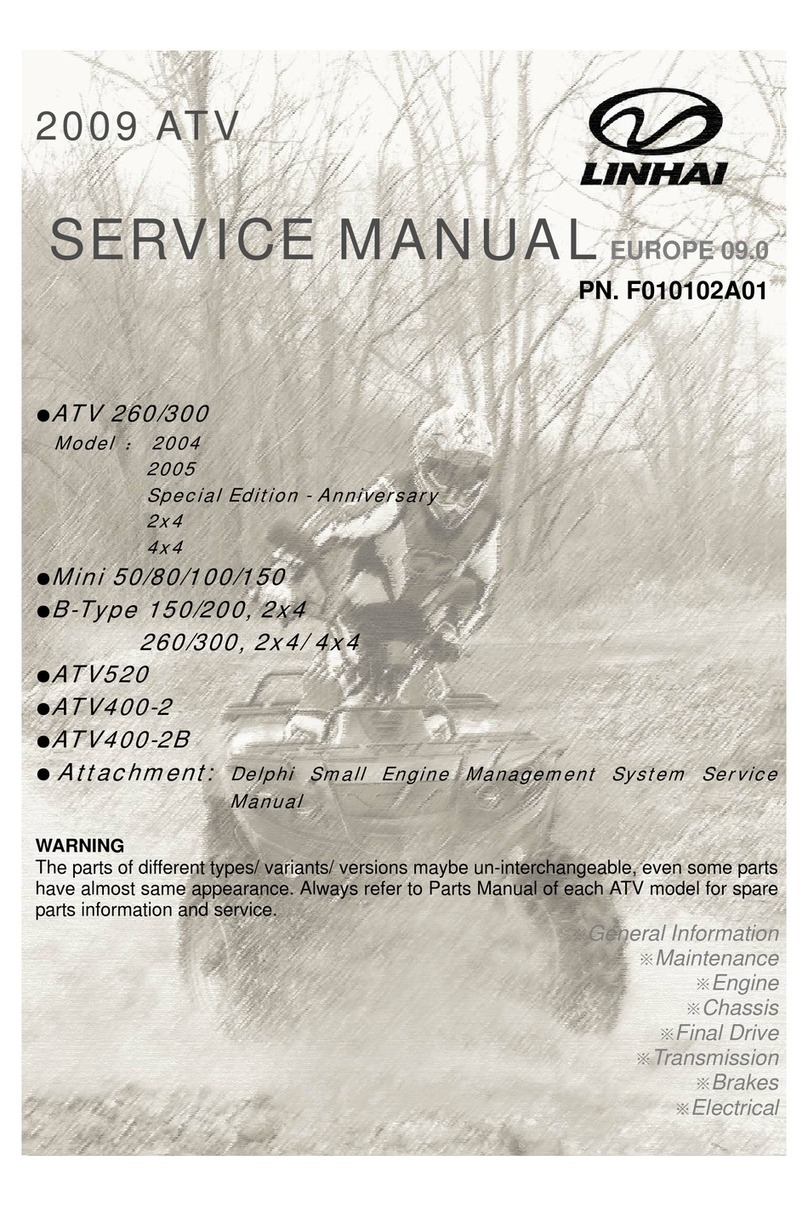
Linhai
Linhai 2004 ATV 260 User manual

Linhai
Linhai LH500ATV-D Owner's manual

Linhai
Linhai M570L 2020 Owner's manual
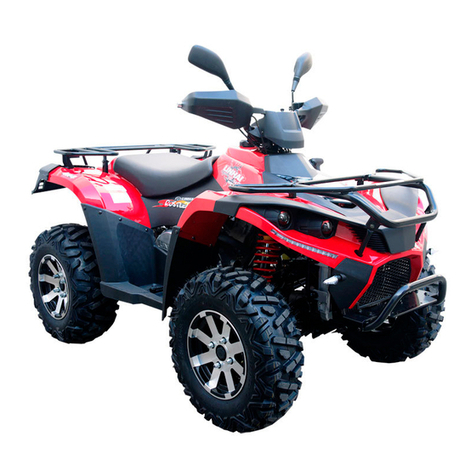
Linhai
Linhai ATV 500-D T3 EFI User manual
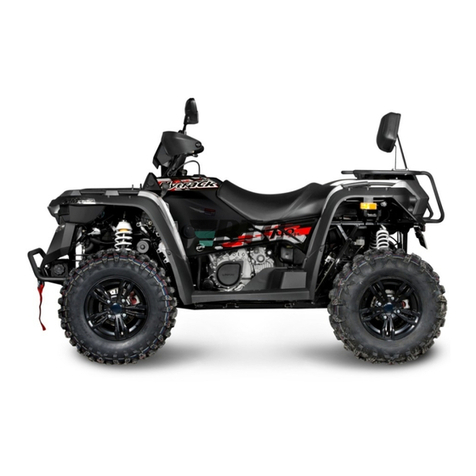
Linhai
Linhai HY740STL 2018 User manual
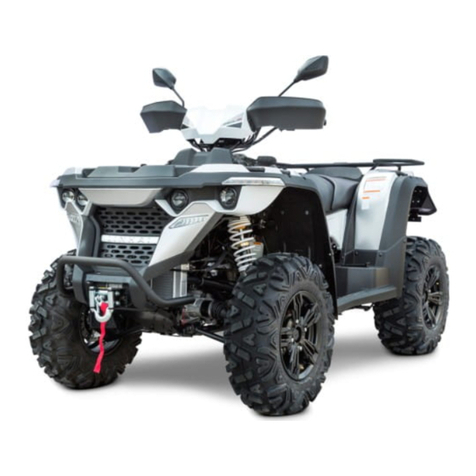
Linhai
Linhai M750L T3 Owner's manual
